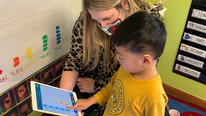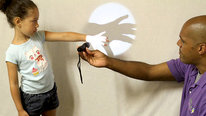- Chandra Orrill
- https://chandraorrill.sites.umassd.edu
- Professor & Director
- Computational Thinking Counts in Elementary Grades: Powerful STEM Teaching and Learning for the 21st Century
- https://ctcounts.sites.umassd.edu
- University of Massachusetts Dartmouth
- Ali Asif
- Doctoral Student
- Computational Thinking Counts in Elementary Grades: Powerful STEM Teaching and Learning for the 21st Century
- https://ctcounts.sites.umassd.edu
- University of Massachusetts Dartmouth
- Shakhnoza Kayumova
- https://www.steamidentity.com
- Associate Professor
- Computational Thinking Counts in Elementary Grades: Powerful STEM Teaching and Learning for the 21st Century
- https://ctcounts.sites.umassd.edu
- University of Massachusetts Dartmouth
- Zhichun Liu
- https://liulukas.com/
- Research Scientist
- Computational Thinking Counts in Elementary Grades: Powerful STEM Teaching and Learning for the 21st Century
- https://ctcounts.sites.umassd.edu
- University of Massachusetts Dartmouth
- Eleanor Richard
- Doctoral Student
- Computational Thinking Counts in Elementary Grades: Powerful STEM Teaching and Learning for the 21st Century
- https://ctcounts.sites.umassd.edu
- University of Massachusetts Dartmouth
- Kimberly Welty
- Grant Support Specialist
- Computational Thinking Counts in Elementary Grades: Powerful STEM Teaching and Learning for the 21st Century
- https://ctcounts.sites.umassd.edu
- University of Massachusetts Dartmouth
Public Discussion
Continue the discussion of this presentation on the Multiplex. Go to Multiplex












jennifer Knudsen
What a great project. I love that you are doing project based learning and taking a PD approach. We take a making and curriculum approach to CT and math. We should talk!
Kimberly Welty
Grant Support Specialist
Thanks Jennifer for watching our video. I'll be sure to share your post with Chandra Orrill, our PI.
Nathan Holbert
Associate Professor
Thanks for sharing your work! I appreciate the attention you're paying to teachers adoption and use of CT ideas and practices. I wonder if you can share a bit about what you're learning with regard to aspects of your PD program that are most successful as well as those that maybe haven't worked quite as well as expected. Are there particular strategies, experiences, or even technologies (I see you're using Photon) that you've found to be more accessible or valuable to the teachers you've worked with?
Chandra Orrill
Professor & Director
Thank you for stopping by! We are still early in our process, but my feeling so far is that pairing after school PD with "individualized" coaching has made a huge difference. We added the coaching this semester. Teachers can meet with the facilitator one-on-one or in small groups. It has made a tremendous difference in the uptake of the ideas of the PD. The coaching is done virtually, which works out really well for the coach and the teachers.
For technology, we originally wanted to bring in a variety of technologies over the life of the program. However, it seems that just using Photons is enough. This is, in part, because of the wide range of incoming knowledge of technologies the participating teachers have. But, it's also because Photon allows so many pathways to programming ranging from drawing lines with your finger to block coding to Python. The issue with Photon - that I think would be true with any technology - is the teachers struggle to separate or integrate CT with Photon. To them, either Photon IS computational thinking or Photon is something they have to do in addition to CT. It's very interesting!
Joshua Danish
Professor and Program Chair
Great! One thing I've noticed in our own PD is that while the teachers love the coaching, they tend to not have time to continue all of the ideas after coaching is done. Are you seeing similar issues? Or do you have strategies in mind to keep the teachers working with these great ideas? All of this is understandably complicated by COVID and other factors, and I love seeing how others have helped teachers in these challenging times. Thanks!
Chandra Orrill
Professor & Director
We will be continuing to work with them through summer and next year. We have had a lot of issues with implementation in classrooms, as you might expect, but, now that state testing is wrapping up, we are seeing more - which is exciting! The original (pre-covid) plan was to work with them for 3 years - that was the way we were going to keep them engaged. We are having to make it up as we go a bit at this point because covid has really disrupted everything normal.
Joshua Danish
Professor and Program Chair
This is really wonderful and I look forward to seeing your next round of findings! One thing I wondered also was whether you have a sense of whether your participants were already interested or pushed / pulled in by administration or your enticing advertising? I imagine those who came in with an interest in CT would react differently than those who maybe were less excited but went for it? Or who were pushed in by policy / admin? Do you have any sense of that mix / balance?
Chandra Orrill
Professor & Director
I think there is a mix. In one district, most of the teachers are non-tech teachers. They are regular classroom teachers, ELL, and STEM (science & engineering) teachers. I think most of them volunteered or were arm-twisted by their colleagues, not admin. The other district is, I think, all STEM or technology teachers who work under a single director. I suspect they were strongly encouraged. The ones who teach tech classes, though, were excited because they are without a curriculum and are looking for anything that can help.
Joshua Danish
Joshua Danish
Professor and Program Chair
Awesome! Thanks for sharing. It's sad that teachers are often excited for any help they can get (because we don't have more structural support), but then really inspiring that projects like this one can be there to provide that help!
Chandra Orrill
Professor & Director
I totally agree. I wish we had a curriculum for them to use - right at this moment, it would get great uptake!
Josh Sheldon
Project Lead
I'm intrigued. CT for primary grades is a topic near to my heart, though I haven't had the opportunity to work on a project that integrates it with core subjects.
I really appreciate that you've adopted a model with ongoing PD and coaching - that's so crucial to teacher learning & success.
It's also interesting to hear how teacher get involved - I've definitely been there w.r.t. recruitment & "voluntoldment".
Early in the video, there's mention of tools for a second-language classroom - have you worked with such classrooms so far, and do you have anecdotal observations about what works, what doesn't, and what is interesting and/or unexpected in those classrooms?
What are your early takeaways about designing for sustainability & equitable deployment? I know that's an enormous question, but can you offer one or two most salient ideas you've uncovered?
Chandra Orrill
Professor & Director
We are working with one ELL classroom and this week is the first time we've been able to observe in it. So, we don't have any thoughts yet. Stay tuned. :-)
As far as sustainability and equitable deployment - those are so big and I'm not sure if you're asking about sustainable and equitable PD or classroom use. So, I'll answer for PD and you can ask again if you meant classroom implementations. :-) Because of a really strange series of events, we had to turn all of the PD design and implementation over to our PD partner (Eduscape). That is leading us to have a PD design that is a reusable framework. When we (the researchers) were doing it, we were creating a plan that was highly customized to our exact group. I think moving to Eduscape, in the end, is going to result in an approach that can be replicated and used over and over again - which will help with making it accessible to more teachers. It was a happy accident. Equity in PD is harder. I think we are learning a lot about face-to-face versus virtual, which can open opportunities not otherwise available. I think COVID has provided us with a lot of opportunities to move things virtual that would previously have been unthinkable. (I see that as a small victory in the chaos that has been the last few years.) Does that help?
Josh Sheldon
Project Lead
Hi Chandra.
I'll look forward to hearing more about the ELL classroom implementation.
Too funny re: sustainable & equitable deployment - I *think* I heard that phrase in your video and was curious to learn more about what you meant. They're definitely big issues & compounded by the need for PD AND classroom equity and sustainability. Then there's the question of what one means by equity & sustainability in PD - probably we're talking about the top level, ensuring PD implementations are as equitable and sustainable as possible, but there's the first derivative, which we're doing in a project I currently work on, in which we're facilitating educators as they grow their own equity practices for the classroom and plan for scenarios that will make CS more equitable.
I definitely agree about the learning around value of virtual and/or in-person - both have merits, but virtual affords more flexibility in many cases.
I'll poke around to learn more about Eduscape - they sound like an interesting organization. Glad it seems to be working and providing unexpected benefits.
We're not that far away from each other, though getting out of Boston in traffic could make it seem farther. I did some work in your direction with Global Learning Public Charter School years back. Neat school.
Chandra Orrill
Professor & Director
Ah - in our video we were taking about teachers continuing to integrate CT once we are gone and using it with all of their students. Our best approach to that so far is prolonged PD (more than one year) with the coaching. There are a lot of preconceived notions of what some students can or cannot do that need to be challenged. I am hoping that can be part of our work next year. I would consider what we are doing as a form of nudging (a la Zandra de Araujo's work) because we are offering a deep experience, but only pushing them a tiny bit to implement. Given the current state of schools and teachers' stress levels, small nudges with support seem to be our most promising tool to get them to try things out - particularly with the students who "can't" do whatever the barrier thing is.
Global Learning is a great place. We have a bunch of interesting schools down here. Hopefully, you and I will cross paths more since we are working in very similar spaces intellectually and physically. :-) We do some work near Boston, but not quite in Boston - Boston traffic is real.
Josh Sheldon
Project Lead
Oh yes, we (myself included) do not give young learners nearly enough credit for what they can do. They have capabilities that are amazing, often different from what adults can do, and so we undervalue and have lower expectations than we should.
And yes, educators are very understandably close to breaking points. Anything more than gentle nudging is uncalled for.
I do hope we'll connect.
Karen Royer
I love this project. I think I would have really enjoyed a classroom where CT was more explicitly incorporated. Have you found that additional subjects other than the obvious math or science are easier to incorporate into the project? Are hands on activities also part of the project?
Zhichun Liu
Research Scientist
Thanks Karen! We actually do have teachers from areas outside of math and science (e.g., ELA and ESL). We see computational thinking as a skill set that is related to students' problem solving process, which is connected to pretty much everything that we learn. For example, teachers have been identifying the similar skills behind how to develop an essay and how to program a robot. In terms of hands-on activities, yes! We have incorporated a variety of different hands-on activities for teachers to experience how CT manifests itself in various problem solving activities and plan their lessons where CT and students' learning intersect.